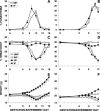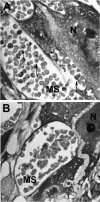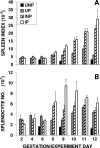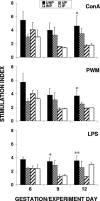Murine malaria infection induces fetal loss associated with accumulation of Plasmodium chabaudi AS-infected erythrocytes in the placenta
- PMID: 16622222
- PMCID: PMC1459757
- DOI: 10.1128/IAI.74.5.2839-2848.2006
Murine malaria infection induces fetal loss associated with accumulation of Plasmodium chabaudi AS-infected erythrocytes in the placenta
Abstract
Malarial infection in nonimmune women is a risk factor for pregnancy loss, but the role that maternal antimalarial immune responses play in fetal compromise is not clear. We conducted longitudinal and serial sacrifice studies to examine the pathogenesis of malaria during pregnancy using the Plasmodium chabaudi AS/C57BL/6 mouse model. Peak parasitemia following inoculation with 1,000 parasite-infected murine erythrocytes and survival were similar in infected pregnant and nonpregnant mice, although development of parasitemia and anemia was slightly accelerated in pregnant mice. Importantly, pregnant mice failed to maintain viable pregnancies, most aborting before day 12 of gestation. At abortion, maternal placental blood parasitemia was statistically significantly higher than peripheral parasitemia. Infected mice had similar increases in spleen size and cellularity which were statistically significantly higher than in uninfected mice. In contrast, splenocyte proliferation in response to mitogenic stimulation around peak parasitemia was statistically significantly reduced in both groups of infected mice compared to uninfected, nonpregnant mice, suggesting that lymphoproliferation is not a good indicator of the antimalarial immune responses in pregnant or nonpregnant animals. This study suggests that while pregnant and nonpregnant C57BL/6 mice are equally capable of mounting an effective immune response to and surviving P. chabaudi AS infection, pregnant mice cannot produce viable pups. Fetal loss appears to be associated with placental accumulation of infected erythrocytes. Further study is required to determine to what extent maternal antimalarial immune responses, anemia, and placental accumulation of parasites contribute to compromised pregnancy in this model.
Figures





Similar articles
-
Association of malaria-induced murine pregnancy failure with robust peripheral and placental cytokine responses.Infect Immun. 2009 Nov;77(11):4998-5006. doi: 10.1128/IAI.00617-09. Epub 2009 Aug 17. Infect Immun. 2009. PMID: 19687196 Free PMC article.
-
Plasmodium chabaudi AS induces pregnancy loss in association with systemic pro-inflammatory immune responses in A/J and C57BL/6 mice.Parasite Immunol. 2012 Apr;34(4):224-35. doi: 10.1111/j.1365-3024.2012.01355.x. Parasite Immunol. 2012. PMID: 22251385 Free PMC article.
-
Malaria-induced murine pregnancy failure: distinct roles for IFN-gamma and TNF.J Immunol. 2009 Oct 15;183(8):5342-9. doi: 10.4049/jimmunol.0901669. Epub 2009 Sep 25. J Immunol. 2009. PMID: 19783682 Free PMC article.
-
Cytoadhesion of Plasmodium falciparum-infected erythrocytes and the infected placenta: a two-way pathway.Braz J Med Biol Res. 2006 Dec;39(12):1525-36. doi: 10.1590/s0100-879x2006001200003. Braz J Med Biol Res. 2006. PMID: 17160261 Review.
-
Malaria, erythrocytic infection, and anemia.Hematology Am Soc Hematol Educ Program. 2009:87-93. doi: 10.1182/asheducation-2009.1.87. Hematology Am Soc Hematol Educ Program. 2009. PMID: 20008186 Free PMC article. Review.
Cited by
-
Helicobacter Infection Significantly Alters Pregnancy Success in Laboratory Mice.J Am Assoc Lab Anim Sci. 2017 May 1;56(3):322-329. J Am Assoc Lab Anim Sci. 2017. PMID: 28535868 Free PMC article.
-
Malaria in pregnancy: the relevance of animal models for vaccine development.Lab Anim (NY). 2017 Oct 6;46(10):388-398. doi: 10.1038/laban.1349. Lab Anim (NY). 2017. PMID: 28984865 Free PMC article. Review.
-
Impact of Infections During Pregnancy on Transplacental Antibody Transfer.Vaccines (Basel). 2024 Oct 21;12(10):1199. doi: 10.3390/vaccines12101199. Vaccines (Basel). 2024. PMID: 39460363 Free PMC article. Review.
-
Malaria in Pregnancy: From Placental Infection to Its Abnormal Development and Damage.Front Microbiol. 2021 Nov 11;12:777343. doi: 10.3389/fmicb.2021.777343. eCollection 2021. Front Microbiol. 2021. PMID: 34867919 Free PMC article. Review.
-
Placental Malaria: A New Insight into the Pathophysiology.Front Med (Lausanne). 2017 Jul 25;4:117. doi: 10.3389/fmed.2017.00117. eCollection 2017. Front Med (Lausanne). 2017. PMID: 28791290 Free PMC article. Review.
References
-
- Abdalla, S., and D. J. Weatherall. 1982. The direct antiglobulin test in P. falciparum malaria. Br. J. Haematol. 51:415-425. - PubMed
-
- Abdalla, S., D. J. Weatherall, S. N. Wickramasinghe, and M. Hughes. 1980. The anaemia of P. falciparum malaria. Br. J. Haematol. 46:171-183. - PubMed
-
- Anonymous. 1997. World malaria situation in 1994. Wkly. Epidemiol. Rec. 72:269-276. - PubMed
-
- Beier, J. C., C. N. Oster, F. K. Onyango, J. D. Bales, J. A. Sherwood, P. V. Perkins, D. K. Chumo, D. V. Koech, R. E. Whitmire, C. R. Roberts, et al. 1994. Plasmodium falciparum incidence relative to entomologic inoculation rates at a site proposed for testing malaria vaccines in western Kenya. Am. J. Trop. Med. Hyg. 50:529-536. - PubMed
Publication types
MeSH terms
Grants and funding
LinkOut - more resources
Full Text Sources
Medical
Research Materials

